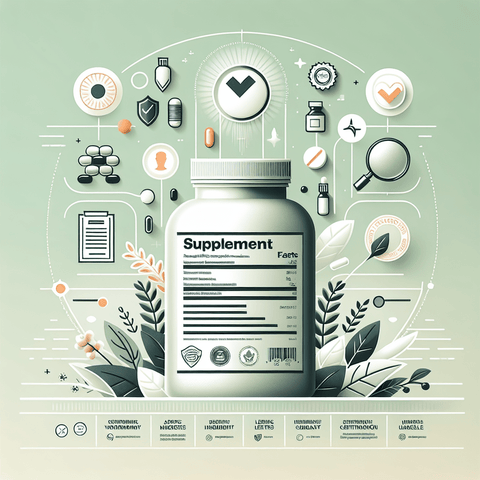Introduction
In recent years, the popularity of nutritional supplements has skyrocketed. From boosting immunity and enhancing energy to supporting bone health and improving overall wellness, dietary supplements have become a staple in many people's health regimens. With this surge in use, consumers are faced with a multitude of products from various brands, each promising a myriad of health benefits. However, with such a vast market and the often complex nature of supplement formulations, making informed choices can be challenging. This underscores the critical importance of understanding supplement labeling—what information it provides, how to interpret it, and what signals to look for to ensure safety and efficacy.
Supplement labeling serves as the primary source of information about the product, guiding consumers in selecting options that align with their health goals. Yet, misconceptions and misinterpretations about labels are common. Many rely solely on front-label claims, flashy packaging, or marketing promises, often neglecting the detailed information that could reveal the true quality or safety of the supplement. This ignorance can lead to purchasing ineffective or contaminated products, or even risking adverse health effects. Therefore, developing literacy around supplement labels is an essential step towards safeguarding one’s health and making responsible, evidence-based choices.
Supplement Labeling: The First Step Toward Safer and More Effective Nutritional Choices
Supplement labeling refers to the information mandated or provided on the packaging and container of dietary supplements. This includes the Supplement Facts panel, ingredient list, serving size, warnings, manufacturer details, and claims about health benefits. The purpose of these labels is to inform consumers about what’s in their supplements, how much to take, and what benefits they might expect, facilitating safer and more effective usage.
Regulations shape what is presented on supplement labels primarily through agencies like the U.S. Food and Drug Administration (FDA), the Federal Trade Commission (FTC), and comparable bodies worldwide. These regulations set basic standards for ingredient disclosure, claim substantiation, and labeling accuracy. While the FDA oversees product safety and mandates certain labeling requirements, an important aspect is that dietary supplements are not subjected to pre-market approval like pharmaceuticals. Instead, manufacturers are responsible for ensuring their products are safe and accurately labeled, with the FDA stepping in mainly if issues arise post-market.
Despite regulations, there are common misconceptions surrounding supplement labels. For instance, many consumers believe that all claims on a label are FDA-approved; however, the reality is that most supplement claims are not evaluated by the FDA before sale. Additionally, some think that “natural” equates to “safe” or "high quality," which is not always the case. Others may interpret ingredient lists as comprehensive, unaware that many products contain hidden fillers, artificial additives, or unlisted contaminants.
Given these complexities, consumers must learn to read and interpret labels correctly. Doing so involves understanding legal terminology, scrutinizing ingredient disclosures, and discerning between verified health claims and marketing hype. Developing this skill set is the cornerstone of making informed decisions that prioritize personal health and safety.
Nutritional Information: Deciphering What’s Really Inside Your Supplements
The nutritional information section, often presented on the Supplement Facts panel, provides crucial data about the content of each supplement. Key elements include serving size, nutrient quantities, and the percentage of the Daily Value (%DV). Understanding this information is vital because it helps you determine whether a supplement provides an adequate amount of specific nutrients and whether it complements your dietary needs.
The significance of serving size and dosage information cannot be overstated. Serving size indicates how much of the product constitutes a single dose, and it affects the interpretation of nutrient amounts listed. For example, a label might show a high vitamin C content per serving, but if the serving size is extraordinarily small, the actual intake in a typical dose could be negligible. Conversely, an oversized serving size could lead to excessive intake, possibly causing adverse effects.
Micronutrients such as vitamins and minerals—like vitamin D, magnesium, or vitamin K—are often listed with their quantities and %DV. These help consumers evaluate whether they are meeting daily nutritional requirements. It’s vital to compare these values to dietary guidelines or consult with healthcare professionals to establish appropriate intake levels, especially when combining multiple supplements.
Many supplements also contain added sugars, fillers, or non-nutritive ingredients that might not be immediately obvious. Added sugars can contribute unnecessary calories and affect metabolic health, whereas fillers or artificial additives might trigger allergies or sensitivities in some individuals. Carefully reviewing the ingredients list, alongside the nutritional facts, provides a fuller picture of what you are ingesting.
Assessing the actual nutritional benefit based on label data involves considering not only the %DV but also the bioavailability and formulation of the ingredients. For instance, certain forms of vitamins and minerals are better absorbed than others. Consumers should also be cautious of misleading claims, such as exaggerated percentages or unsupported health benefits, which often appear on labels to entice buyers.
For example, a supplement claiming to contain "high potency" vitamin D might be appealing, but it’s important to verify if the dose aligns with recommended daily allowances. Moreover, some labels include unsubstantiated claims about health benefits, which could be designed more for marketing than for factual accuracy. Being vigilant in scrutinizing these aspects ensures you select products with genuine nutritional value.
Ingredient Transparency: Why Knowing What’s in Your Supplements Matters
Full ingredient disclosure is critical for consumer safety and informed decision-making. Clear labeling of all ingredients—active, inactive, fillers, preservatives, artificial colors, and flavorings—allows consumers to identify potential allergens, sensitivities, or ingredients they wish to avoid. Hidden ingredients or vague descriptions can obscure potential risks, leading to unintended adverse reactions or interactions with medications.
Common hidden fillers include artificial dyes, synthetic preservatives, binders, or flow agents like silicon dioxide. Artificial additives such as sweeteners, flavorings, or coloring agents might pose concerns for certain individuals, especially those with allergies or sensitivities to these substances. Furthermore, some supplements may contain undeclared allergens, such as nuts, shellfish, or soy, which can have severe health consequences.
Labels versus actual product composition is another area of concern. Manufacturing inconsistencies, contamination, or mislabeling can result in products that differ from their label claims. Verifying product authenticity and purity involves checking for adequate ingredient declarations and seeking information on manufacturing processes. Reliable brands often provide batch-specific data, third-party testing results, and transparency reports to build consumer trust.
Maintaining ingredient transparency fosters consumer confidence and ultimately promotes safer supplement use. When labels clearly specify all ingredients and disclose any potential cross-contaminants, consumers can make choices aligned with their health needs and preferences. This transparency is especially vital for individuals with allergies, sensitivities, or those following strict dietary regimens, such as vegetarians or vegans.
Labeling Regulations: Navigating the Legal Landscape for Supplement Accuracy and Safety
Understanding the regulatory framework governing supplement labeling helps consumers recognize legitimate products and avoid those that may be misleading or unsafe. Regulatory bodies such as the FDA and FTC establish standards for what must be included on labels, how claims are substantiated, and what constitutes truthful advertising.
The FDA requires supplement manufacturers to include a Supplement Facts panel, ingredient list, allergen information, and manufacturer details. Claims about health benefits must be supported by scientific evidence, though they are often categorized within permitted claims, such as structure/function claims. The FTC monitors advertising claims for truthfulness and can penalize false or deceptive marketing practices.
However, limitations and loopholes exist. Many supplements are marketed with claims that imply therapeutic effects without FDA approval, or they lack rigorous testing to substantiate these claims. Since dietary supplements are classified as food products rather than drugs, they are not subjected to the rigorous pre-market approval process applicable to pharmaceuticals. This can enable the entry of products with exaggerated claims or lower quality standards.
Recent regulatory changes aim to improve product transparency and safety, including stricter requirements for labeling of domestic and imported supplements, post-market testing, and adverse event reporting. Nonetheless, consumers should remain vigilant—researching manufacturers, avoiding products with questionable labeling practices, and seeking third-party certifications are wise steps to ensure product integrity.
The Supplement Facts Panel: Your Go-To Guide for Healthy Choices
The Supplement Facts panel is the cornerstone of supplement labeling, providing a standardized format to present nutrient content and serving information. Its key components typically include serving size, servings per container, a list of nutrients with quantities, %Daily Values, and sometimes additional notes or warnings.
Efficiently reading and interpreting this panel involves checking the serving size against your typical dose, verifying the amounts of key nutrients relevant to your health goals, and noting the %DV to gauge whether a product provides a significant contribution to your daily needs. For example, if a magnesium supplement offers 200 mg per serving, knowing the recommended daily allowance (around 310-420 mg depending on age and sex) helps decide if it’s appropriate for you.
Mandatory information includes the name of each nutrient and its amount, while optional data may include additional ingredients or warnings. Spotting red flags such as unusually large or small serving sizes, missing %DVs, or unsubstantiated claims can prevent ineffective or risky supplementation. For instance, some products might list very high doses that could be unsafe without medical supervision.
Practical tips involve comparing labels across brands, checking for consistent ingredient quantities, and reviewing third-party testing certifications. By developing a systematic approach to reading the Facts panel, consumers can make better-informed, safer choices tailored to their individual health needs.
Quality Assurance: Ensuring You Receive Pure, Potent, and Safe Supplements
Quality assurance in supplement manufacturing is paramount to ensure the products are pure, effective, and free from contaminants. Third-party testing organizations such as USP (United States Pharmacopeia), NSF International, and the Non-GMO Project provide independent verification of supplement quality, potency, and safety. Certifications from these organizations offer additional confidence beyond the product label.
Manufacturing standards involve Good Manufacturing Practices (GMP), which specify quality control processes, sanitation protocols, and consistent production procedures. Verified supplements undergo rigorous testing for contaminants such as heavy metals, pesticides, microbes, or adulterants before reaching the market.
To verify the authenticity and potency of your supplements, look for batch-specific certificates of analysis (COAs), verification seals, and transparency reports from reputable brands. Red flags indicating low quality include products with missing or inconsistent batch details, unusual odors or colors, or reports of contamination.
Building confidence involves selecting brands that prioritize third-party certifications, maintain transparent manufacturing processes, and have positive consumer reviews. Prioritizing quality assurance safeguards your health and helps you maximize the benefits of your supplements.
Putting It All Together: How to Become a Knowledgeable and Discerning Supplement Consumer
To become an empowered supplement consumer, it’s essential to synthesize all the information covered. Key takeaways include the importance of scrutinizing the Supplement Facts panel, understanding ingredient disclosures, verifying third-party testing, and recognizing marketing claims that lack scientific support. Developing a habit of reading labels critically ensures you choose products that meet safety, efficacy, and quality standards.
Practical steps involve researching brands before purchase, consulting reliable resources, and seeking advice from healthcare professionals when in doubt. Utilizing online tools and databases can help verify ingredient authenticity and check for recalls or adverse reports. Additionally, choosing products from reputable sources, such as trusted online stores or certified local health stores, minimizes the risk of counterfeit or substandard items.
Mindfulness in supplement selection extends beyond labels to include considerations of your health goals, dietary restrictions, and existing medical conditions. A balanced approach combines scientific literacy with personalized health needs, ensuring that supplement use genuinely supports your wellness journey.
Conclusion
Knowledge is your most potent tool in navigating the complex world of dietary supplements. By understanding the importance of supplement labeling, decoding nutritional information, scrutinizing ingredient transparency, and verifying quality assurance, you can make choices that genuinely benefit your health. Vigilance, critical thinking, and staying informed are essential pillars for safeguarding oneself against low-quality or unsafe products.
Empowering yourself with this knowledge allows you to prioritize safety and efficacy, ensuring that your supplement regimen complements your overall health goals effectively. Remember, the key to optimal health is not just about choosing the right supplements but also about making informed, deliberate decisions backed by understanding and evidence.
Stay curious, keep learning, and always read labels carefully. Your health and well-being depend on it.
Q&A Section
Q1: Why is it important to understand supplement labels?
A1: Understanding supplement labels helps you identify the actual contents, effective dosages, and any potential risks or allergens, enabling safer and more effective supplement choices.
Q2: What should I look for on a Supplement Facts panel?
A2: Focus on serving size, key nutrients offered, their quantities, %Daily Values, and any warnings or notes. Be wary of unusual serving sizes or missing information.
Q3: How can I verify the quality of a supplement?
A3: Look for third-party certifications such as USP, NSF, or Non-GMO Project. Check for batch-specific Certificates of Analysis and buy from reputable brands with transparent manufacturing practices.
Q4: Why is ingredient transparency important?
A4: Full ingredient disclosures ensure you are aware of all substances in the product, helping you avoid allergens, artificial additives, or undeclared contaminants that could be harmful.
Q5: How do regulations affect supplement labeling, and what should I be aware of?
A5: Regulations mandate essential label information, but manufacturing and marketing practices vary. Some claims may lack scientific backing, and supplements are not pre-approved like medicines, so remain cautious and diligent.
Important Keywords
- Supplement Labeling
- Nutritional Supplements
- Supplement Facts Panel
- Ingredient Transparency
- Third-Party Testing
- Supplement Regulations
- Quality Assurance
- Consumer Safety
- Health Claims
- Supplement Certifications
- Supplement Safety
- Informed Supplement Choices
- Dietary Supplements
- Manufacturing Standards
- Supplement Risks
- Effective Supplement Use
- Supplement Label Interpretation
- Supplement Quality Control



